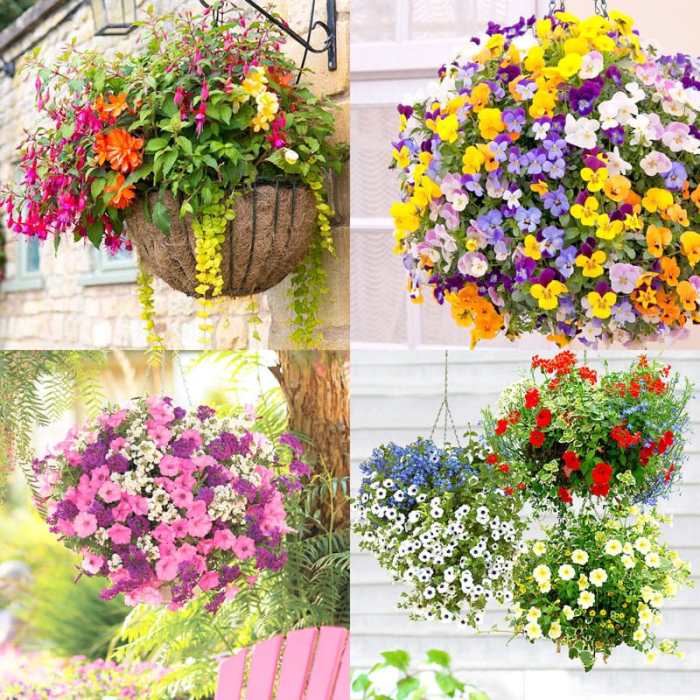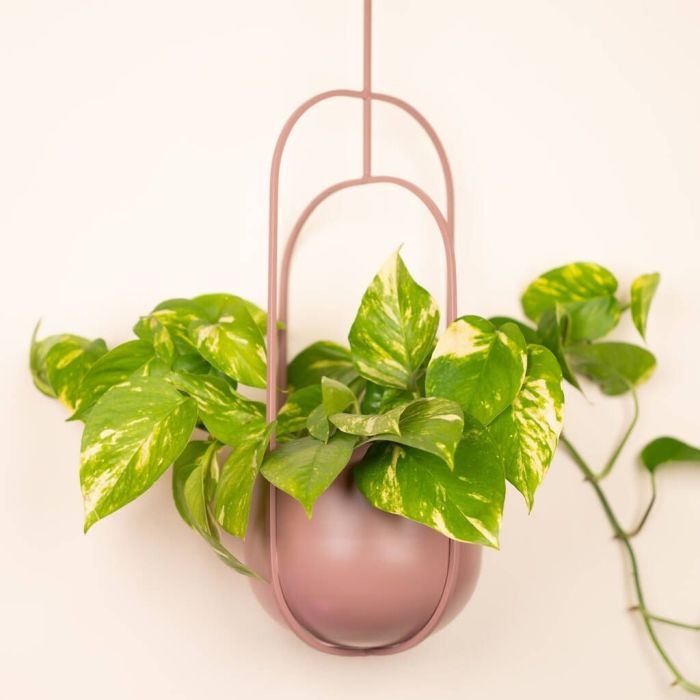Discover the best plants for hanging pots indoors and elevate your living space with lush greenery. From trailing vines to air-purifying wonders, these plants will add beauty and vitality to any room.
Hanging plants bring a touch of nature indoors, creating a serene and inviting atmosphere. Whether you’re a seasoned plant enthusiast or just starting out, this guide will provide you with all the essential information to keep your hanging plants thriving.
List of Suitable Plants for Hanging Pots
Hanging plants add a touch of greenery and elegance to indoor spaces. Their trailing stems and lush foliage create a cascading effect that can instantly transform any room. Moreover, many hanging plants are known for their air-purifying qualities, helping to improve indoor air quality.
When selecting plants for hanging pots indoors, it’s essential to consider their specific needs and adaptations. Some plants thrive in low-light conditions, while others prefer bright, indirect light. Some have trailing stems that gracefully cascade over the pot’s edge, while others have upright or bushy growth habits.
Trailing Plants
- Pothos (Epipremnum aureum) : Known for its trailing stems and heart-shaped leaves, pothos is a low-maintenance plant that tolerates low light conditions and occasional neglect.
- Philodendron (Philodendron scandens) : This plant has glossy, heart-shaped leaves and trailing stems that can reach several feet in length. It prefers bright, indirect light but can tolerate low light conditions.
- String of Hearts (Ceropegia woodii) : This charming plant features heart-shaped leaves with variegated patterns. Its trailing stems make it an ideal choice for hanging baskets or macrame hangers.
Air-Purifying Plants
- Spider Plant (Chlorophytum comosum) : This easy-to-grow plant produces long, arching leaves with white and green stripes. It is known for its air-purifying abilities and is effective in removing toxins from the air.
- Peace Lily (Spathiphyllum wallisii) : This elegant plant features glossy, dark green leaves and white flowers that resemble peace lilies. It is known for its ability to remove formaldehyde and other pollutants from the air.
- Snake Plant (Sansevieria trifasciata) : This low-maintenance plant has sword-like leaves with a striking green and yellow pattern. It is highly effective in removing toxins and is known for its resilience in low-light conditions.
Environmental Requirements and Care Tips

To ensure the health and aesthetic appeal of your hanging plants, it is crucial to provide them with their optimal environmental conditions. This includes meeting their specific lighting, temperature, and humidity requirements.
Most hanging plants prefer bright, indirect light. Avoid placing them in direct sunlight, as this can scorch their leaves. Ideal temperature ranges vary depending on the plant species, but most prefer moderate temperatures between 65-75°F (18-24°C). Humidity levels should also be moderate, and you can increase humidity by misting the plants regularly or using a humidifier.
Watering Frequency
Watering frequency is crucial for maintaining the health of your hanging plants. Overwatering can lead to root rot, while underwatering can cause the plants to wilt and lose their vigor. The best approach is to water the plants when the top inch of soil feels dry to the touch.
Allow the excess water to drain out of the pot before replacing it in its hanger.
Fertilization Schedules
Regular fertilization provides essential nutrients for the growth and health of your hanging plants. Fertilize the plants monthly during the growing season (spring and summer) with a balanced liquid fertilizer diluted to half strength. Avoid over-fertilizing, as this can damage the roots.
Pruning Techniques
Pruning is essential for maintaining the shape and size of your hanging plants. Remove any dead or damaged leaves and stems as they appear. You can also prune the plants to encourage bushier growth or to control their height. When pruning, use sharp, clean shears to make precise cuts.
Design and Aesthetic Considerations

Incorporating hanging plants into interior design can transform a space, adding vibrant hues, captivating textures, and a touch of nature’s allure. These verdant adornments enhance visual interest, creating a sense of depth and dimension within a room.
Pot Selection and Placement
Choosing the appropriate pot size, shape, and material is crucial to complement the plant’s growth habit and enhance the overall decor. Consider the plant’s root system and growth rate when selecting a pot size, ensuring ample space for healthy development.
Hanging plants are a great way to add life and color to your indoor space. But not all plants are created equal when it comes to hanging pots. Some of the best plants for hanging pots indoor include pothos, spider plants, and ferns.
These plants are all relatively easy to care for and can tolerate a variety of light conditions. If you’re looking for a more unique option, you can also try some of the best indoor plants for hanging planters . These plants are a bit more challenging to care for, but they can add a touch of drama and elegance to your home.
Opt for pots with drainage holes to prevent waterlogging and root rot.
When it comes to selecting the best plants for hanging pots indoor, there are numerous options to consider. For those seeking a touch of tranquility in their bedrooms, the best hanging plant for bedroom can provide a calming atmosphere. These plants, such as lavender or peace lilies, not only purify the air but also promote relaxation and restful sleep.
By incorporating these plants into hanging pots, you can elevate your indoor decor while creating a serene ambiance in your bedroom. Whether you’re a seasoned plant enthusiast or just starting out, the best plants for hanging pots indoor offer a versatile and visually appealing way to enhance your living spaces.
Shape and material play a significant role in aesthetic appeal. Round pots soften the ambiance, while angular shapes add a modern touch. Ceramic pots offer durability and a classic look, while woven baskets exude a bohemian vibe. Suspend plants from the ceiling or mount them on walls to maximize space utilization and create a captivating visual display.
Plant Combinations and Display Ideas

Mixing different plant species in hanging pots can create visually appealing displays. Experiment with contrasting foliage, flower colors, and growth patterns. For instance, pair trailing plants like pothos with upright ones like snake plants. Combine colorful flowers of petunias with the variegated leaves of coleus.
When choosing the best plants for hanging pots indoor, consider trailing plants that thrive in low light conditions. Best low light trailing plants like pothos, philodendron, and spider plants can add a touch of greenery to any room, even those with limited natural light.
These plants are not only easy to care for but also help purify the air, making them an excellent choice for both homes and offices.
Arranging Hanging Plants
Explore creative ways to arrange hanging plants. Macrame hangers add a bohemian touch, while tiered shelves create a cascading effect. Suspend plants from ceiling hooks to create a vertical garden. Consider the height and spread of each plant to ensure they don’t overcrowd or block light.
Troubleshooting Common Issues

Indoor hanging plants can encounter various challenges that affect their health and appearance. Understanding these issues and implementing effective solutions is crucial for maintaining thriving indoor greenery.
Common problems include:
- Yellowing leaves
- Pest infestations
- Stunted growth
Yellowing Leaves
Yellowing leaves can indicate nutrient deficiencies, overwatering, or insufficient light. To address this:
- Check soil moisture and adjust watering frequency.
- Fertilize regularly with a balanced plant food.
- Provide adequate sunlight or use artificial grow lights.
Pest Infestations
Aphids, spider mites, and mealybugs are common pests that can infest hanging plants. To combat them:
- Isolate infected plants to prevent spread.
- Use insecticidal soap or neem oil to treat infestations.
- Encourage natural predators like ladybugs and lacewings.
Stunted Growth, Best plants for hanging pots indoor
Stunted growth can be caused by rootbound plants, insufficient nutrients, or inadequate lighting. To resolve this:
- Repot plants into larger containers with fresh soil.
- Increase fertilizer application or switch to a higher-nutrient blend.
- Provide more light or move plants to a brighter location.
Wrap-Up
With the right care and attention, hanging plants can bring years of joy and beauty to your indoor space. Experiment with different species, create stunning plant combinations, and enjoy the benefits of having a touch of nature in your home.
FAQ: Best Plants For Hanging Pots Indoor
What are the most popular hanging plants for indoors?
Some of the most popular hanging plants for indoors include pothos, spider plants, philodendrons, and ferns.
How often should I water hanging plants?
The watering frequency for hanging plants will vary depending on the species, but generally, they should be watered when the top inch of soil feels dry to the touch.
How can I create a stunning hanging plant display?
To create a visually appealing hanging plant display, consider mixing different plant species with contrasting foliage, flower colors, and growth patterns. Experiment with using macrame hangers, tiered shelves, or ceiling hooks to arrange your plants in creative ways.